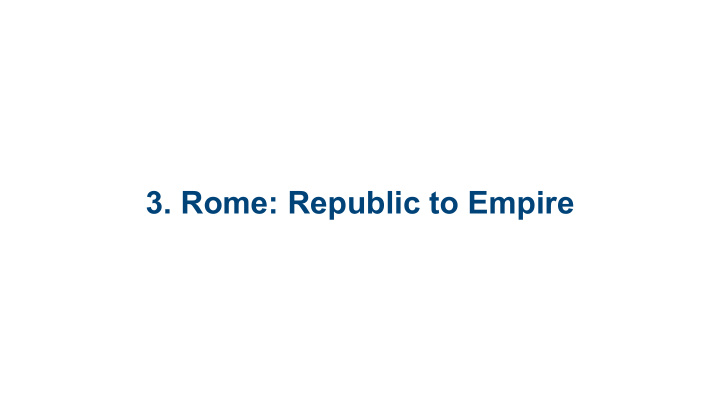



3. Rome: Republic to Empire
3.1. Foundational Elements of Roman Society: Power of Tradition 3.2. Roman Organizational Genius 3.3. Government and Law in the Republic
3.4. The Punic Wars: 264–146 B.C.E. 3.5. Socio-Economic Trends of Imperialism 3.6. Decline of the Republic
3.7. The Principate of Augustus Caesar 3.8. Imperial Prosperity: Too Many Frontiers 3.9. Diocletian and Constantine
3.10. The Invasions and Challenge of Christianity 3.11. Church Fathers: Jerome and Augustine
3.1. Foundational Elements of Roman Society: Power of Tradition
• Heroic Myths: Romulus, Horatius, Lucretia, Cincinnatus • The “father of the family”
• Patricians (old elite) • Plebeians (non-elite)
3.2. Roman Organizational Genius
• Monarchy to Republic: Good Government • Organization: Alphabet Soup of Offices/Titles
• Consuls with IMPERIUM (command) • The Roman Senate
3.3. Government and Law in the Republic
• The Struggle of the Orders 494 BCE, Army Mutiny • The 12 Tables of Law, Separate and Unequal • By 287 BCE All Equal Under Law
• Father’s Power • Female Guardianship • Property Rights, Debt • Intermarriage
3.4. The Punic Wars: 264–146 B.C.E.
• The First Punic War, 264-241 BCE • Control of Sicily, Naval vs. Army Tactics • Roman Navy Developed • Sicily Taken, $$$
• The Second Punic War, 218-201 BCE • Control of Spain, Sardinia & Corsica • Carthaginian Army Developed, Hannibal
• Roman Expansionism • Carthage Razed, 146 BCE, 3 rd Punic War
3.5. Socio-Economic Trends of Imperialism
• Expansion: Slaves, Plunder, Jobs, Prestige, Land • Collapse of Small Farming Class
3.6. Decline of the Republic
Land Reform: Tiberius Gracchus
Army Reform: Marius Landless, Professional, Soldiers Loyal to Leader as the Path to Power
Julius Caesar (100-44 BCE) • Victor in Spain 60 BCE • Held Army Command in Gaul • Marched on Rome in 49 BCE, Triumphant in Rome, 45 BCE
• Julius Caesar Master of Rome, Dictator for Life • Senatorial Power Weak, Real Power is the Army • Senatorial Enemies Organized Conspiracy to Assassinate Caesar
3.7. The Principate of Augustus Caesar
• Octavian Pursued Enemies of Julius Caesar • Proscription Policy • Defeat & Death of Antony/Cleopatra, 30 BCE
• Octavian Controls Rome, Accumulates Titles: CAESAR, PRINCEPS, AUGUSTUS • Total Domination of Rome: Army, Law, Taxes, Economics, Religion • Ruled until 14 CE, “King?”
3.8. Imperial Prosperity: Too Many Frontiers
• “A RED GIANT?” Is expansion always a sign of strength? • Challenges: Language, Law, Transport, Religion • Origins of the West and East Division
3.9. Diocletian and Constantine
• Emperor Diocletian (r. 284-305) “The Rule of Four” • Economic Edicts: Prices, Labor, Taxes • Christianity Assaulted
Emperor Constantine
• Battle of Milvian Bridge 312, Edict of Milan 313 • Christianity Accepted as a Legal Religion • Council of Nicaea 325: What is Christianity?
3.10. The Invasions and Challenge of Christianity
• The Roman Empire as a highway … . • Push/Pull out of Asia • New Culture: Roman Fused with Migrants
3.11. Church Fathers: Jerome and Augustine
St. Augustine of Hippo
St. Jerome
• Jerome (d. 420): The Vulgate Bible, Standard Latin Text • Augustine of Hippo (d. 430): Confessions & City of God, Celibacy • Monasticism • Petrine Supremacy
Recommend
More recommend